#Shutter capture utility
Explore tagged Tumblr posts
Text





Vibrant Frame (청춘프레임) Release dates (Windows, Steam) Korean: October 26th, 2023 English, Japanese and Chinese: December 16th, 2024
"A story that will capture the most brilliant moments of ours.
Every freshman dreams of the perfect college life—bursting with passion and eager to conquer every challenge. From heart-wrenching love affairs to shaking off heartbreak with a drink, the journey is filled with ups and downs.
But as time passes, reality sets in. Students worry about the future, calculating relationships that might benefit them later.
This story is a slice of life for seniors stepping into the real world, holding onto their dreams one last time.
Players step into the shoes of the protagonist, ‘Seong Ah-ri’, navigating through the story and utilizing the ‘Shutter Chance’ to pursue the main character, ‘Cha Han-joo,’ unlocking various endings.
Experience a dramatic romance story between you and Cha Han-joo, reflecting our reality with 100% pure emotions."
This is a commercial visual novel by Lumiere Entertainment Inc! You can buy it or download the demo from Steam here.
#otome game#otome games#vibrant frame#청춘프레임#visual novel#gxb#lumiere entertainment inc#windows#steam#demo#voice acting#commercial#video
110 notes
·
View notes
Text
Yvette Heiser - Teaches Photography Basics in Texas
Photography, an art form that captures moments in time and tells stories through imagery, is accessible to everyone willing to learn. Yvette Heiser, a renowned photographer based in Texas, has made it her mission to help budding photographers master the fundamentals of this beautiful craft. With her extensive experience and passion for teaching, Yvette offers insightful guidance on how to transform a simple photograph into a captivating piece of art. Here’s an in-depth look at what Yvette Heiser– Learn the fundamentals of photography with Yvette Heiser, Texas and classes entail and the strategies she employs to help her students excel.

The Basics of Photography with Yvette Heiser
Understanding the Camera
The journey into photography begins with understanding the camera, the primary tool of the trade. Yvette Heiser’s classes start with a comprehensive overview of different types of cameras, including DSLRs, mirror less cameras, and even smartphones. She explains the fundamental components such as the lens, sensor, viewfinder, and memory card, ensuring that her students are well-versed in the basic anatomy of their equipment.
Mastering Camera Settings
One of the key aspects of Yvette’s teaching is demystifying camera settings. She breaks down the exposure triangle—aperture, shutter speed, and ISO—highlighting how these elements interact to create a perfectly exposed photograph. Students learn how to adjust these settings based on different lighting conditions and desired effects, such as depth of field and motion blur.
Composition and Framing
Rule of Thirds
Yvette emphasizes the importance of composition in photography. One of the first rules she teaches is the rule of thirds, a fundamental principle that helps create balanced and engaging images. By dividing the frame into nine equal parts, students learn to position their subject along these lines or at their intersections, resulting in a more dynamic and aesthetically pleasing composition.
Leading Lines and Symmetry
Yvette also explores advanced composition techniques such as leading lines and symmetry. Leading lines draw the viewer’s eye towards the main subject, creating a sense of depth and guiding the viewer through the image. Symmetry, on the other hand, introduces balance and harmony, making the photograph more visually appealing. Through practical exercises, students develop an eye for these elements and learn to incorporate them into their work.
Lighting Techniques
Natural Light
Lighting is a crucial element in photography, and Yvette Heiser’s classes cover the basics of working with natural light. Students learn to observe and utilize different qualities of natural light, from the soft, diffused light of a cloudy day to the harsh shadows of midday sun. Yvette teaches techniques for shooting during the golden hour and blue hour, times when natural light is most flattering and dramatic.
Artificial Light and Flash Photography
In addition to natural light, Yvette introduces her students to artificial lighting techniques. She covers the basics of flash photography, including on-camera and off-camera flash, and how to use reflectors and diffusers to control and modify light. These lessons equip students with the skills to handle various lighting situations, both indoors and outdoors.
In the digital age, smartphones have revolutionized the way we capture and share moments. With their advanced cameras and user-friendly features, smartphones have become powerful tools for photography, accessible to everyone and Yvette Heiser Texas: A Complete Guide to Mastering Phone Photography from Texas has made it her mission to help individuals unlock the full potential of their smartphone cameras.
Basic Editing Techniques
Post-processing is an integral part of modern photography, and Yvette Heiser ensures her students are proficient in basic editing techniques. Using software like Adobe Light room and Photoshop, students learn how to adjust exposure, contrast, colour balance, and sharpness to enhance their images. Yvette emphasizes the importance of maintaining a natural look while correcting minor flaws and bringing out the best in each photograph.
Creative Editing and Filters
Beyond basic adjustments, Yvette encourages her students to explore creative editing. She introduces concepts such as black-and-white conversions, selective color, and the use of filters to create unique and artistic effects. By experimenting with different techniques, students discover their own style and develop a personal artistic vision.
Practice and Patience
Yvette Heiser believes that practice and patience are key to mastering photography. She advises her students to take their cameras everywhere and practice shooting in different conditions and environments. This hands-on experience helps them understand their equipment better and develop a keen eye for composition and lighting. Yvette reminds her students that photography is an art that requires time and dedication, and progress often comes through trial and error.
Continuous Learning and Inspiration
Another strategy Yvette advocates is continuous learning and seeking inspiration. She encourages her students to study the work of famous photographers and understand the techniques they use. Attending workshops, reading books on photography, and participating in online communities can provide new perspectives and ideas. Yvette also suggests keeping a photography journal to document progress and reflect on what works and what doesn’t. This continuous learning process helps photographers stay inspired and motivated to improve their craft.
In addition to traditional camera techniques, Yvette Heiser also offers insights into mastering phone photography. With the advancements in smartphone camera technology, learning to take stunning photos with your phone has become more accessible than ever. Yvette’s guide to phone photography covers essential tips and tricks for capturing high-quality images, utilizing the various features and settings available on smartphones
Conclusion
Yvette Heiser’s dedication to teaching photography basics in Texas has helped countless students develop their skills and passion for this art form. Through her comprehensive classes and practical strategies, she empowers aspiring photographers to capture the world around them with creativity and confidence. Whether you’re using a professional camera or your smartphone, Yvette’s guidance ensures that you can create beautiful, impactful images that tell a story.
#camera#photographer#wedding#moments#photography#yvette heiser#pictures#childphotography#photographytips#events
7 notes
·
View notes
Text

It was an extraordinary scene.
Donald Trump, recently re-elected as president of the United States, found himself surrounded by women and girls in the East Room of the White House. The date was 5 February 2025 and Trump was signing an executive order entitled "Keeping Men Out of Women’s Sports." As the president took to his desk and prepared his pen, he invited his all-female audience to draw closer. "Secret Service is worried about them?" he joked. There was laughter, applause, a hubbub of palpable relief that an egregious social injustice was on the cusp of being corrected. Photographers captured the moment in a flurry of snapping shutters. Would this be the image that marked the beginning of our post-woke era? The first phase of sobering up for a once drunken world?
The significance of this event could not be dismissed as a mere publicity. Here was one of the most controversial Republican presidents in history. A man who had been accused repeatedly of misogyny. Nevertheless enacting the most pro-feminist directive since Richard Nixon signed Title IX of the Education Amendments in June 1972, a measure that prohibited sex-based discrimination in federally funded educational institutions.
The culture war of our times has often been misinterpreted as a conflict between left and right, but these designations are hangovers from the French revolution, ill-suited to today’s complex ideological skirmishes.
The sudden rise in the early 2010s of Critical Social Justice, that sprawling, complex and disparate movement known colloquially as "woke," has meant that the terms left and right I’ve lost much of their utility. Definitions of "woke" are as varied as can be imagined, but it is understood as a cultural revolution that seeks equity according to group identity by authoritarian means.
Yet for all its institutional clout, this ideology has never enjoyed popular support. Estimates by More In Common, a nonprofit organisation committed to the promotion of social cohesion, suggest that at its height the woke movement was endorsed by approximately 8% percent of the population of both the US and the UK. As such, it’s power could only ever be sustained through misdirection and imposition.
We now find ourselves entering a new phase of the culture war. One in which the woke ideology is being tamed and will soon relinquish it’s chokehold on the Western world. The death rattles have become so audible that they can no longer be gainsaid.
Major companies such as McDonald’s, Walmart, Ford, Amazon, Google and Meta have scaled-back their diversity, equity and inclusion policies.
Black Lives Matter is now a largely discredited movement.
Leftist politicians such as Democratic representative Alexandria Ocasio-Cortez and the former US Secretary transportation Pete Buttigieg have quietly remove the pronouns from their social media profiles.
Multiple sporting bodies have barred men who identify as women from competing in female categories.
Gay groups are rejecting the forced-teaming with divisive LGBTQIA+ campaigns.
The UK Supreme Court has ruled that sex means biological sex for the purposes of equality law, meaning that men who identify as women have no legal rights to enter women-only spaces. The Telegraph ran with the front page headline: "Trans women are not women."
A seemingly frivolous but perhaps equally revealing moment occurred when car company Jaguar released a new advertisement campaign in November 2024. A short commercial showcased a number of flamboyant, epicene models posing against a minimalist but colourful backdrop with syntactically inelegant slogans such as "live vivid" and "delete ordinary" appearing periodically on the screen. No vehicles with featured and it looked very much as though Jaguar was more interested in promoting the doctrine of DEI rather than selling cars. Inevitably, the company sales soon plummeted but the significance was in the broader reaction. Like many woke initiatives, the concept was rooted in conformism masquerading radicalism. A few die-hard activists praised the company's new direction, but the effort seemed forced. Whimpers, rather than cheers. The faintest borborygmi of an ageing beast. The overriding impression was one of fatigue. An advertisement that would’ve been standard fare in 2020 suddenly felt very dated.
So, is "woke" truly at an end? Well, the influence of woke still lingers of course, and the ideology will doubtless find a way to mutate and resurrect in some other guise. In addition, we’re already seeing the rise of an anti-woke contingent that may fill the vacuum.
In seeking to re-establish the importance of freedom and liberal values, some leading figures of this predominantly right-leaning counter movement have now reached the conclusion that the only effective response to wokery is a different kind of authoritarianism. As they saying has it, they hope to fight fire with fire. And as such, have earned themselves the much contested label of the "woke right."
Those of us who have taken a stance against the excess of the illiberal left would be advised to be vigilant about the possibility of a backlash that will only guarantee the continuation of this culture war. We should be striving to return to a time when absurdities were treated with the indifference they deserve, and the shrilled demands of a handful of ideologues were drowned out by the steady chorus of reason.
My new book, "The End of Woke," is intended to reflect these developments and to show that the authoritarian impulse at the heart of wokeness is replicated wherever human being succumb to ideological thinking. The culture war has been needlessly prolonged due to this common insistence that it can be reduced to a matter of party politics. Far from blaming the left this ongoing societal upheaval, we must acknowledge that culture warriors exist across the political spectrum.
This has never really been a matter of left or right but rather what John Stewart Mill in 1859 called, "the struggle between Liberty and Authority." My concern is how we reached this period of competing narratives and regressive tribal politics, where we might go next, and how we should learn from the recent past to guide us through the imminent future.
It is an argument for the cooling of temperature. The detribalisation of politics. The acknowledgement that no group has all the answers. It is a reminder that we have as much to learn from our critics as they might learn from us. That there is a colonel of truth even in the most grievous falsehood. And that our agency is diminished if we insist on reciting someone else’s script.
--
“The struggle between Liberty and Authority is the most conspicuous feature in the portions of history with which we are earliest familiar, particularly in that of Greece, Rome, and England.” ― John Stuart Mill, "On Liberty"
#Andrew Doyle#The End of Woke#narratives#liberal values#liberalism#classical liberalism#woke right#woke left#wokeness#cult of woke#wokeness as religion#woke#authoritarianism#equity#woke authoritarianism#identity politics#Black Lives Matter#BLM#BLM scam#pronoun culture#pronouns in bio#diversity equity and inclusion#diversity#inclusion#DEI must die#tribalism#religion is a mental illness
2 notes
·
View notes
Video
White-necked Jacobin by Adam Rainoff Via Flickr: The White-necked Jacobin (Florisuga mellivora) is a captivating subject, and I was fortunate to capture this stunning specimen at Reserva Natural EntreAguas in Tolima, Colombia. This shot highlights the male's vibrant blue, turquoise, and white plumage, a striking contrast against the lush green foliage of its natural habitat. Positioned gracefully on a slender branch, the Jacobin's iridescent feathers shimmer in the soft, diffused light of the forest canopy. This image was taken at 1,187 meters above sea level, within the species' typical range up to 1,200 meters across various tropical regions from southern Mexico to western Ecuador, and east through the Caribbean and northern South America. From a technical perspective, achieving this shot required patience and careful observation. The White-necked Jacobin is known for its rapid movements and territorial behavior, making it a challenging subject to photograph. Utilizing a high shutter speed and a wide aperture, I aimed to freeze the motion and capture the intricate details of its plumage. The natural lighting conditions were ideal, providing a soft, even illumination that accentuated the bird's vibrant colors. This image not only showcases the beauty of the Jacobin but also reflects the serene and biodiverse environment of Reserva Natural EntreAguas. ©2021 Adam Rainoff Photographer
9 notes
·
View notes
Text
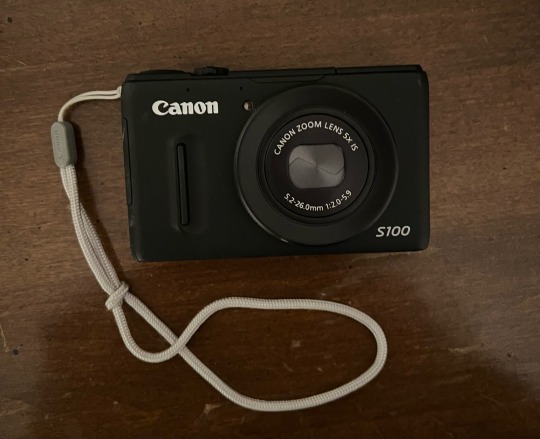
This Canon Powershot S100 is the digital camera I use to take all my photos. My grandpa used it throughout the 2000s and gifted it to me.
After receiving this camera, I throughly researched the camera’s technicalities to familiarize myself with this new tool. I began by familiarizing myself with its basic functions, specifically the shutter speed, ISO settings, and the menu settings. I experimented with the image stabilization to ensure well-focused and clear photos. I took advantage of the macro mode for close-up, detailed photography. Once I captured my photos, I reviewed them on the LCD screen to utilize the editing features, including the exposure, contrast, and color balance. Not only did I use the basic editing features, but I also transferred them to my phone for additional post- processing editing using Adobe Lightroom, an editing software.
#digicam#photography#canon powershot#canon photography#digital camera#my photography#camera#canon#camerasetup#camera settings
9 notes
·
View notes
Note
Headcanons for Photographer!Miu?
o7
The minute Miu got her hands on one of those toy film cameras as a kid, it was over for everyone. She couldn’t get enough of photography, even though those pictures were pretty bad in hindsight.
She knew just about everything there was to know about the different cameras she could use, how to utilize light and different angles to get the best pictures possible of anything.
Her online store with prints of her photos was incredibly popular, which she was very proud of. She said that she wasn’t surprised by it, but she really didn’t think she’d take off like that.
It was very rare to see her without some kind of camera with her. Her classmates were used to the sound of the shutter going off in the middle of class so she could capture the light on something like right.
Some of her favorite photos of hers were of capturing people in imperfect moments. Not necessarily embarrassing or anything, but just showing the reality of people in general.
4 notes
·
View notes
Text
Life and Pictures: Entry #5
The Science of Light: Mastering Illumination in Photography

Building on our exploration of memories, narratives, and emotions in photography, let's delve into a fundamental yet often underappreciated element: light. Understanding and mastering light can transform your photography, adding depth, texture, and mood to your images.
Why Light in Photography Matters Light is the essence of photography. The word "photography" itself means "drawing with light." Light determines the visibility, contrast, color, and mood of a photograph. Mastering light enables you to control these aspects, enhancing the storytelling and emotional impact of your images.
Elements of Light in Photography
Quality of Light:
Soft Light: Produced by diffuse sources like overcast skies or softboxes, soft light creates gentle shadows and a flattering effect, ideal for portraits.

Hard Light: Created by direct, undiffused sources like the sun on a clear day or a bare bulb, hard light produces sharp shadows and high contrast, emphasizing texture and details.

Direction of Light:
Front Light: Illuminates the subject from the front, reducing shadows and creating a flat, even effect.

Side Light: Comes from the side, adding depth and texture by casting shadows and highlighting contours.

Back Light: Illuminates the subject from behind, creating silhouettes and dramatic effects.

Top and Bottom Light: Light from above or below can create unusual and striking effects, often used for dramatic or artistic purposes.

Color Temperature:
Warm Light: Light with a yellow or orange hue (e.g., golden hour sunlight), evoking warmth and intimacy.

Cool Light: Light with a blue hue (e.g., shade or overcast daylight), creating a calm or somber mood.

Intensity of Light:
Bright Light: High-intensity light creates vivid, high-contrast images.

Low Light: Low-intensity light can produce soft, moody, or atmospheric images.

Techniques for Mastering Light
Natural Light Photography: Utilize different times of the day to capture various lighting effects. Early morning and late afternoon offer soft, warm light, while midday sun provides harsh, direct light. Use reflectors to bounce light onto your subject, filling in shadows and balancing exposure.

Artificial Light Photography: Experiment with studio lighting setups, such as using multiple light sources, softboxes, and diffusers to control light quality and direction. Use colored gels to alter the color temperature and create creative lighting effects.

Understanding Exposure: Master the exposure triangle (aperture, shutter speed, ISO) to control how much light enters the camera and how it affects the final image. Use exposure compensation to adjust the brightness of your image in challenging lighting conditions.
youtube
Light Modifiers: Employ tools like reflectors, diffusers, and flags to modify and control light. Reflectors can bounce light, diffusers can soften it, and flags can block or shape it.
youtube
Practical Applications and Projects
Golden Hour Project: Photograph the same subject at different times during the golden hour to study how changing light affects the mood and appearance of your photos.

Shadow Play: Focus on capturing shadows and light patterns. Experiment with side lighting to create dramatic effects and highlight textures.

Night Photography: Explore low-light photography by shooting at night. Use long exposures, and experiment with artificial light sources like streetlights, car headlights, or flash.

Portrait Lighting: Practice different lighting setups in portrait photography. Use natural light, studio lights, and reflectors to create various moods and effects.

Light is a powerful tool in photography. By understanding and mastering its different aspects, you can significantly enhance the visual impact and emotional depth of your images. Embrace the science of light, experiment with its many facets, and let it elevate your photographic artistry.
Next time you pick up your camera, pay close attention to the light. Observe how it interacts with your subject, how it changes throughout the day, and how you can manipulate it to create the desired effect. Master the art of illumination and watch your photography transform.
#photography#original photographers#blackandwhitephotography#photographers on tumblr#film photography#photo#photoblog#photographer#life#lifestyle#perspective#leisure#hobbies#hobby#picture#nature#life experiences#my experiences#self expression#expressionism#abstract expressionist art#freedom of expression#35mm#35mm film#35mm photography#Youtube
3 notes
·
View notes
Text
Modern Photography Trends in Urban New York

As we explore modern photography trends in urban New York, we notice a fascinating blend of neon lights and spontaneous moments that truly embody the city’s spirit. Photographers are pushing boundaries with techniques like low shutter speeds to capture motion, while candid shots during the golden hour reveal authentic emotions. We’re also seeing a rise in experimental methods that transform the narrative of urban life into something unexpected. But what does this mean for the future of photography in such a vibrant setting? Let’s consider the implications and what they could signify for both artists and viewers alike.
Neon Lights in Urban Scenes

Neon lights in urban scenes create a vibrant tapestry that captures the essence of city life. In New York City, the interplay of bright pinks, blues, and greens illuminates the streets, making every corner a canvas for modern photography.
As we stroll through the bustling avenues, we can’t help but notice how these neon hues enhance the visual energy around us, especially at night.
Street photography thrives here, where candid moments unfold in front of our lenses. The silhouettes of people walking against the backdrop of vivid lights portray a dynamic atmosphere, suggesting a fast-paced urban existence.
This unique blend of light and shadow invites us to explore the stories hidden within each fleeting moment.
Capturing Motion With Low Shutter Speeds

Urban environments are alive with movement, and capturing that energy is where slow shutter speed photography truly shines. By using slow shutter speeds, we can transform ordinary urban scenes into dynamic images, allowing us to tell a story through motion. This technique captures the pulse of the city, compressing time into a single frame filled with life and energy.
To effectively capture motion, we often rely on specific techniques like the River of Light or the Ghost People Effect. These methods create visually striking compositions that emphasize movement while keeping some elements sharp. A tripod is essential for clarity, especially in low-light conditions, and using shutter priority mode lets us focus on capturing motion without worrying about exposure.
Once we’ve taken our shots, post-processing techniques become crucial. We can sharpen static areas, enhance contrast, and adjust colors to bring out the vibrancy of our images.
Embracing Candid Moments
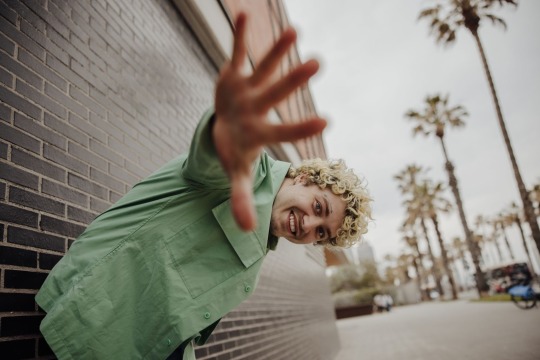
How can we truly capture the essence of daily life in our cities? Embracing candid moments is key to mastering street photography. By focusing on unposed, real-life interactions, we reveal the authentic emotions that define urban settings. We know that spontaneity enhances our images, allowing us to tell stories that resonate with viewers.
Using effective lighting techniques is crucial; the golden hour offers soft, warm light that brings our scenes to life, while harsh midday light can create striking contrasts. As we wander through the streets, we should blend into our surroundings, moving slowly to anticipate those fleeting moments that tell a deeper story. A 35mm or 50mm lens makes it easier to capture these genuine interactions without intruding on the scene.
Moreover, we can experiment with different angles and compositions, utilizing reflections and shadows to add depth and context. By prioritizing authenticity over staged shots, we celebrate the beauty of chaos in everyday life.
Through our photography in New York, we can showcase the vibrant tapestry of humanity that thrives within this bustling city. So let’s grab our cameras and start seeking those candid moments that truly capture urban life!
Storytelling Through Documentary Photography
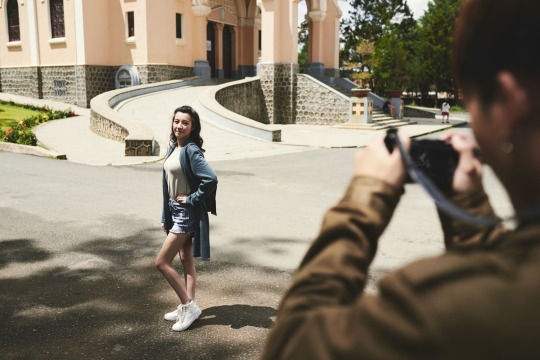
Capturing candid moments in street photography sets the stage for deeper storytelling through documentary photography. We explore how elements like light, emotion, and composition intertwine to create powerful narratives. Each photograph tells a story, much like a scene in a film, where characters, settings, and conflicts come alive.

Experimental Techniques in Photography

Exploring experimental techniques in photography opens up a world of creativity and innovation. We can break away from traditional norms and dive into unique creative processes that challenge our artistic boundaries. Techniques like intentional motion blur allow us to capture movement in an expressive way, making our urban scenes feel alive. By deliberately moving our camera during exposure, we create dynamic visuals that tell a story beyond static images.
Light painting is another fascinating method we can use. With long exposure times, we can illuminate scenes with light sources, crafting shapes and figures that add a magical touch to our photographs. This technique transforms ordinary settings into extraordinary works of art.
Abstract photography pushes us to think outside the box. It invites us to explore unconventional angles and compositions, often leading to intriguing results that spark conversation and contemplation. By layering images or employing soft focus, we can create pieces that evoke emotion and challenge perceptions.
As we experiment with these techniques, we not only enhance our skills but also develop a deeper connection with our urban environments, celebrating the beauty and complexity of city life through our lens.
What Clients Say About Maps studio
At Maps studio, we value the experiences of our clients. We’ve gathered some great reviews from platforms like Google My Business, showcasing the positive feedback we receive from those who have explored urban photography with us. These testimonials reflect our dedication to capturing the vibrant essence of New York City through modern photography techniques. For a closer look at the stunning work we create, visit our website at mapsstudio.nyc.



Frequently Asked Questions
What Is the New Trend in Photography?
We’re seeing a shift towards capturing raw, authentic moments in photography. It’s all about storytelling through candid shots, blending natural light, and using innovative techniques to showcase the vibrant energy of our surroundings.
What Is Urban Style Photography?
Urban style photography captures the vibrant essence of city life. We focus on candid moments and dynamic interactions, using natural light to highlight colors while showcasing the unique stories woven into urban landscapes and cultures.
What Is the Best Street in NYC for Photos?
When we think about the best street in NYC for photos, we can’t help but mention Broadway. Its vibrant lights and energy create stunning backdrops, making it a must-visit for capturing dynamic urban moments.
What Photography Is in High Demand?
We’ve noticed a rising demand for street photography, fashion shoots, and architectural captures. People love authentic moments and unique perspectives that tell stories, making these styles essential for anyone looking to thrive in photography today.
Conclusion
As we explore modern photography trends in urban New York, we see how neon lights, motion capture, and candid moments come together to tell the city’s vibrant story. By embracing experimental techniques and documentary styles, we invite deeper connections with our surroundings. Each photograph we take not only reflects our unique perspective but also contributes to the ever-evolving narrative of this dynamic metropolis. Let’s continue to push boundaries and capture the essence of New York through our lenses.
Visit Maps studio for more information about photography.
#maps modeling studio photos#maps modeling studio reviews#map design studio#maps nyc modeling#maps studio nyc#modeling photography studio#film#maps modeling studio#maps studios boston#modeling studio#photography
1 note
·
View note
Text
Ultraviolet Light Reveals Radiant Hidden Beauty of Flowers
— By Margherita Cole | Published: May 9, 2022

Artist Debora Lombardi shines a light on flowers in her new photo series—literally. The Italy-based designer and photographer uses ultraviolet light to capture the unseen beauty of these plants, revealing dazzling colors and patterns that are otherwise invisible during the daytime.
Lombardi began this project at the start of the COVID-19 pandemic. With just a few tools and plants collected from the condominium garden, she was able to tap into a new world. Since then, Lombardi has continued adding to the series, experimenting with customizations each time. “Ultraviolet induced visible fluorescence photography (UVIVF) is a technique that captures the fluorescence of flowers and plants hit by UV light—and which makes visible what is generally invisible to the naked eye,” she tells My Modern Met. “Photographing in this way reveals vivid, incandescent colors—a chromatic world not detected by human eyes, but that some animals (such as bees) can perceive.”
Each of these stunning photos utilizes a plain black background to emphasize the striking coloration of flowers. This simple composition is reminiscent of portrait photography. “I take my photos in a totally dark environment, illuminating the subject by a UV torch (of those usually used in crime scenes), with shutter speeds ranging from 10 to 30 seconds, and applying technical measures resulting from various experiments,” Lombardi adds. Her photo series was named a finialist in the World Photography Organization awards.
Italy-Based Artist Debora Lombardi Photographs Flowers Illuminated By Ultraviolet Light.


This Technique Reveals The Florescent Colors And Patterns That Are Otherwise Invisible To The Human Eye.


“Photographing In This Way Reveals Vivid, Incandescent Colors,” Says Lombardi.

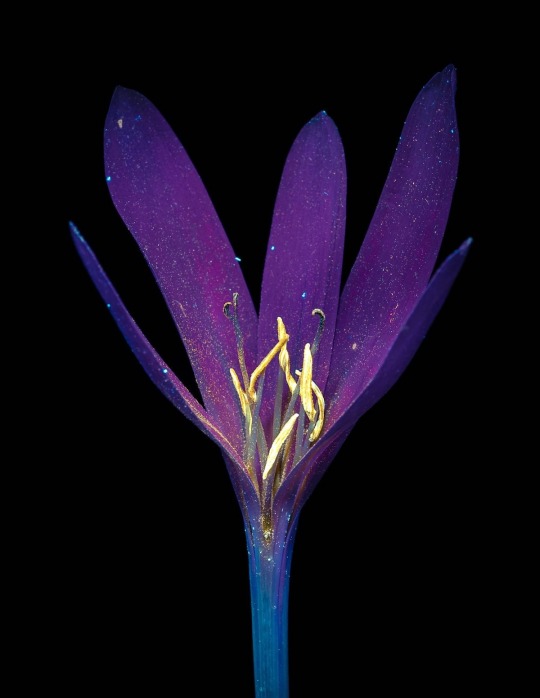
“A Chromatic World Not Detected By Human Eyes, But That Some Animals (Such As Bees) Can Perceive.”


— Margherita Cole is a Contributing Writer at My Modern Met and illustrator based in Southern California. She holds a BA in Art History with a minor in Studio Art from Wofford College, and an MA in Illustration: Authorial Practice from Falmouth University in the UK. She wrote and illustrated an instructional art book about how to draw cartoons titled 'Cartooning Made Easy: Circle, Triangle, Square' that was published by Walter Foster in 2022.
#Ultraviolet Light#Radiant | Hidden | Beauty of Flowers 🌸🌺🌹💐#Margherita Cole#Italy 🇮🇹-Based | Artist | Debora Lombardi#The Florescent Colors | Patterns | Invisible to Human Eye 👁️
3 notes
·
View notes
Note
💀 back at you for leo :)
send in a 💀 to see how aisling would respond to the news of your muse's death.
there are people in the world who are protected. he knows with certainty that he's one of this rare and lucky group. they have the protection of bribed judges, blackmailed politicians, well-financed security guards. they have wealth and influence and connections, a trifecta of ironclad defence systems that renders them nigh-invincible. bullet-proof vehicles, whole platoons of trained and deadly people willing to do unthinkable things to guarantee their safety.
but he's being ridiculous. right? there's no way that she could get past all the guards downstairs. the cameras would capture the wings of a mosquito in the car park. the glass is treated to the extent that it's practically stronger than metal. it's virtually impossible for anyone to get past that. right? right. he's being stupid. since being transported to his office, every last measure has been utilized. all that's left is the security shutters. they even kept the lights off, dim moonlight giving him some view of the left side of the office. still he paces. still he watches his shoes leave frantic marks in the cashmere rug. finally, he lunges for the remote on the desk, just to shut up that goddamn anxiety that screams in every beat of his heart, when his hand strikes a vacant glass space where the remote had been just moments before.
click.
the shutters drop soundlessly, melting into a seamless steel wall over his glass prison cell. the remote is placed back on the desk, and the chair turns slightly to reveal a messed tangle of dark curls over a jarringly resigned face.
" that's not going to help. "
" jesus fuck-- "
" neither is that. though, i understand. you're upset. the family's in witness protection, right? i had to. i know, your family is your strength, i do, believe me. but they need new identities. ones removed from the legacy of their father. it was an act of mercy, i assure you. "
he wonders if she somehow laced the table with a chemical to make his legs feel so weak. he's trying to move to the door, but terror has him moving erratically, and he ends up tripping on the edge of the rug. she doesn't move from the chair.
" i do understand. and so would leo. " there. that fucking name. that goddamn curse of a man who haunts him still. "vincent" feels a bubble of a sob escape him, and scrambles forward for the door, but she interrupts his desperation with a slightly pained sigh. " it's locked, keith. "
" what do you WANT?! "
" bribery's not going to help, either. let me save you the distress of the unknown, keith. you made a choice. nothing leo could've done would change the outcome. i made a choice. and now there's nothing you can do that can change the outcome, too. "
" i have a fa-- "
" had. " now she stands. he shoves himself off the floor, overshoots, and ends up on his back, propped up by his elbows as he tries to scuttle away from her. " you had a family. so do a lot of people, keith. so did leo. "
" they'll look for me! "
" who? oh. no. they made that quite clear. it was the only question they asked. your former wife actually hugged me when i told her that they were never going to see you again. except, of course, the obituary photos. though maybe we can substitute a flower, spare the poor readers the hardship of seeing you on the page amongst their loved ones. " she stops by his side, and lowers a hand to him.
" i'll do anything-- "
" have some dignity, keith. stand up. " he doesn't. she sighs again, sharply this time, and grips his shoulder, illuminating his whole body with an eerie light. it feels like someone's turned him into a puppet. he disconnects from his body, watches his limbs smoothly rearrange until he's upright, crouched down to accommodate her stature. when the light fades, she nods, then lifts her hand to his temple, pressing her thumb against it. " you deprived him of this. dignity. cowardice is like a disease, and you infected everyone with it. see... leo was a lot of things. a complicated man. but not a damn soul, living nor dead, could accuse him of being a gutless coward. and you took that from him. then you took him from me. "
keith finds himself unable to do anything but stand there and weep.
" he was a good man. people figure you need to be good 24/7, but that's not possible. he did his best. even when he lost against doctor apocalypse. you know how many would've just fled? hid? begged for mercy? not him. he lost. but he fucking fought. he wasn't perfect. but he let me have my imperfections too. i loved him. and he's gone now. "
" please-- "
" that's not going to help. "
he's dead before he hits the ground.
#death tw#death mention tw#( ' a soul for a soul... ' / reply. )#raisedcold#( THIS HAS BEEN IN MY SKULL FOR WEEKS NOW )#( I CAN'T )#( THIS IS PROBABLY HER FIRST TIME ADMITTING THE L WORD IN RELATION TO HIM TOO </3 )
1 note
·
View note
Text
The Ultimate Guide to Drone Photography in Dubai
Introduction
Action Filmz celebrated for its futuristic skyline and stunning landscapes, has evolved into a haven for drone photography Dubai enthusiasts. Join us in this Ultimate Guide as we explore the art of capturing breathtaking aerial shots in this mesmerizing city.
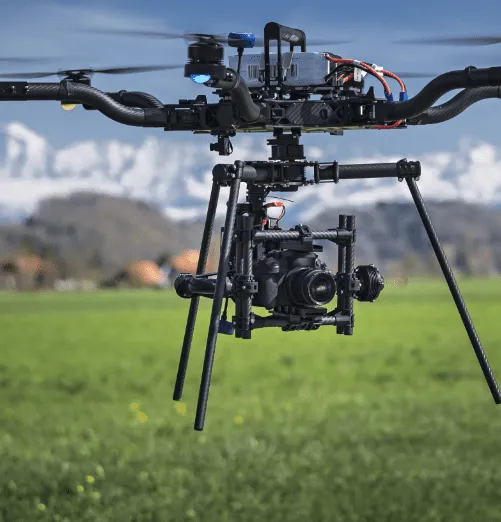
Getting Started with Drone Photography
Selecting the right drone is crucial for a successful photography venture. Models with advanced camera features and stability functions are ideal. Understanding the basics, such as GPS capabilities and flight modes, ensures a smoother experience.
2. Legal Considerations
Before soaring into the Dubai skies, it's vital to be aware of local regulations. Obtaining the necessary permits and adhering to specific guidelines set by authorities is essential to avoid legal complications.
3. Planning Your Drone Photography Session
Action Filmz offers a plethora of iconic locations for aerial photography in Dubai. From the Burj Khalifa to the Palm Jumeirah, each spot provides a unique perspective. Additionally, considering weather conditions is crucial for a safe and successful shoot.
4. Tips for Capturing Stunning Aerial Shots
Adjusting camera settings, such as ISO and shutter speed, can significantly impact the quality of your photos. Experimenting with different angles and compositions adds creativity to your aerial portfolio.
5. Editing and Enhancing Drone Photos
After the flight, the editing process is where your images truly come to life. Utilize recommended editing tools to enhance colors, contrast, and sharpness, ensuring your photos stand out.
6. Showcasing Your Drone Photography
Building a portfolio and sharing your work on social media platforms helps you connect with other drone enthusiasts. It's a great way to gain recognition and feedback on your aerial masterpieces.
7. Common Challenges and How to Overcome Them
Issues like limited battery life and connectivity problems are common in drone photography. Understanding how to tackle these challenges ensures a smoother and more enjoyable experience.
8. Future Trends in Drone Photography
As technology advances, so does drone photography. Stay updated on the latest trends, from improved camera capabilities to new shooting styles, to stay ahead in the game.
9. Testimonials and Success Stories
Hear from successful drone photographers who have explored the skies of Dubai. Their experiences and tips can provide valuable insights for aspiring aerial photographers.
Conclusion
Explore the thrilling realm of drone photography in Dubai with this exciting adventure. Aerial photography, aerial videography, and aerial filming options abound due to the city's renowned monuments and constantly shifting terrain. For your next photography expedition, Action Filmz has a vast array of opportunities, regardless of your level of drone expertise.
Call Action Filmz at +971 43416638 or visit https://actionfilmz.com/ for additional information about aerial photography and filming in Dubai.
#drone photography dubai#drone photography company#film production company dubai#aerial photography dubai#drone filming companies in dubai#drone videography dubai#aerial photography companies#aerial filming and photography#film production companies in dubai#video production company in dubai
3 notes
·
View notes
Text
Yvette Heiser - How Mastering Photography Fundamentals Can Improve Your Night-Time Food Shots
Night-time food photography presents both challenges and opportunities for photographers looking to capture the delicious allure of culinary creations. With low light conditions and the need for effective composition, mastering the fundamentals of photography becomes essential. Yvette Heiser - Mastering Night-time Food Photography provides valuable tips and techniques for overcoming these challenges and capturing stunning food shots even in the darkest settings.

Understanding the Importance of Photography Fundamentals
Photography fundamentals encompass essential concepts such as exposure, composition, lighting, and focus. By mastering these foundational elements, photographers can effectively capture the essence of their subjects—especially in challenging conditions like nighttime settings. Yvette Heiser - Click with Confidence: Mastering Photography Fundamentals offers valuable insights into these core principles, helping photographers build a solid foundation for capturing stunning images in any environment.
1. Exposure: Balancing Light and Darkness
Exposure refers to the amount of light that reaches your camera sensor, affecting how bright or dark your image appears. In night-time food photography, achieving the right exposure is crucial to highlight details while avoiding overly dark or washed-out images.
Key Tips for Managing Exposure:
Use a Wide Aperture: A wide aperture (e.g., f/2.8 or f/4) allows more light to enter the camera, making it easier to shoot in low-light conditions. This also creates a beautiful background blur (bokeh) that emphasizes your subject.
Adjust ISO Settings: Increasing your ISO sensitivity can help capture images in low light. However, be cautious—higher ISO settings can introduce noise. Aim for the lowest ISO that allows you to achieve a properly exposed image.
Utilize Longer Shutter Speeds: Slowing down your shutter speed allows more light to hit the sensor. Use a tripod to stabilize your camera during longer exposures, preventing motion blur.
2. Lighting: Creating Atmosphere and Mood
Effective lighting is crucial in night-time photography, as it sets the mood and enhances the visual appeal of your food shots. Natural light may be limited, so understanding how to manipulate artificial light sources is essential.
Lighting Techniques for Night-Time Food Photography:
Use Soft Light: Soft, diffused lighting is ideal for food photography. Consider using softboxes or LED lights with diffusers to create even lighting without harsh shadows.
Incorporate Ambient Light: Utilize available ambient light sources—such as candles, string lights, or lamps—to create a warm and inviting atmosphere. Experiment with different angles to see how the light interacts with your subject.
Control Shadows: Be mindful of shadows in your composition. Use reflectors (like white foam boards) to bounce light onto darker areas, ensuring your food remains enticing and well-lit.
3. Composition: Framing Your Subject
Composition is the art of positioning elements within your frame to craft a visually engaging and harmonious photograph. Effective composition can draw attention to the food while providing context about the setting.
Tips for Strong Composition in Night-Time Food Photography:
Rule of Thirds: Use the rule of thirds by dividing your frame into a 3x3 grid. Place your main subject along these lines or at their intersections to create balance and interest.
Frames Within Frames: Use elements in your environment (like plates or utensils) to create frames within your composition. This technique adds depth and guides the viewer’s eye toward the main subject.
Negative Space: Incorporate negative space around your food subject to emphasize it further. This technique helps prevent clutter and allows viewers to focus on the dish itself.
4. Focus: Sharpening Your Subject
Achieving sharp focus on your culinary subject is vital in food photography. In low-light conditions, it can be challenging to maintain focus, but mastering this skill will elevate your night-time shots.
Focus Techniques for Crisp Images:
Manual Focus: In low-light situations, autofocus may struggle. Switch to manual focus to ensure precise control over which elements are sharp in your image.
Use a Tripod: A tripod stabilizes your camera and helps achieve sharper images, especially when using slower shutter speeds. This is particularly useful for night-time photography where motion blur can easily occur.
Focus on Key Details: Highlight specific features of the dish—such as texture or garnishes—by focusing closely on those areas. This adds visual interest and draws attention to the quality of the food.
Mastering photography fundamentals is essential for anyone looking to improve their night-time food shots. By understanding exposure, lighting, composition, and focus, photographers can create stunning images that showcase their culinary creations in the best possible light. With practice and experimentation, you’ll find that these fundamental skills not only enhance your night-time photography but also enrich your overall photographic journey. So grab your camera, experiment with these techniques, and watch as your night-time food photography transforms into mouthwatering works of art!
#wedding#pictures#camera#moments#photographytips#photographer#photography#childphotography#yvette heiser#events
6 notes
·
View notes
Text
Disrupt Project - Lighting workshop
On Monday I participated in the lighting workshop, we set up spaces to take portrait photos of each other and got familiar with the utilities and lighting equipment in the space, all of the photos are based on the Disrupt theme.
In groups, we used our phone cameras automated functions to compare results of normal portrait shots to disrupted shots that included fabrics, unique lighting and poses that disrupted the normality of the photos.
After we were introduced to the DSLR camera we then did this exercise again with the more advanced equipment and manual settings on the camera for a mixture of shutter speed and aperture.
Resources on camera work were given to us so we could expand the work we are doing in the workshop.
After being introduced to the workshop I now feel comfortable to revisit the studio and use it for work from other workshops.
Some photos taken of myself with the phone camera disrupted with sheer sequinned fabric in-front of the camera.
I edited the middle photo on photoshop.
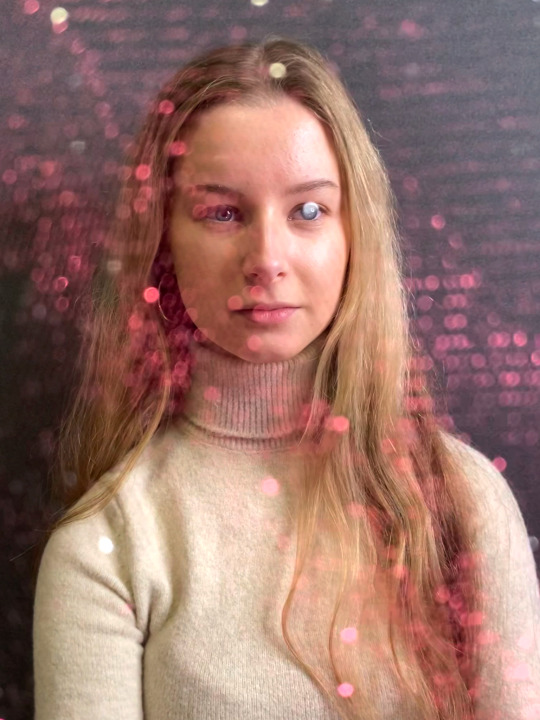
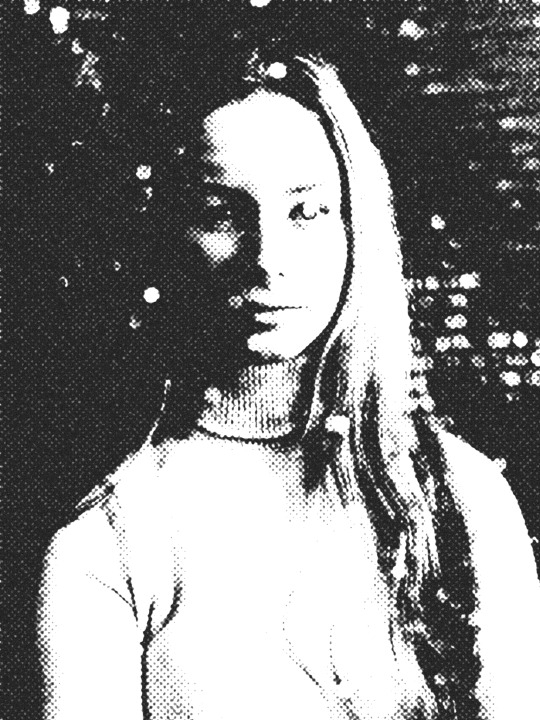
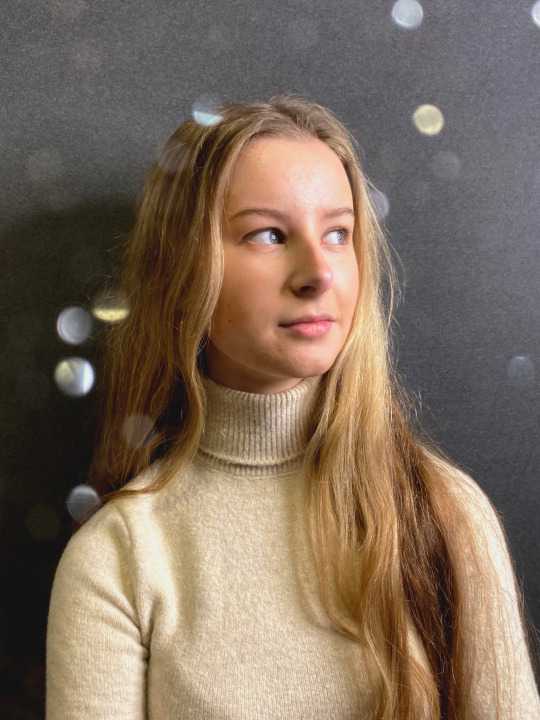
Here are some of the photos that I took of a member from my group. My group came up with the idea to use the slow shutter speed function and move a torch in the dark to capture the movement and lines from it.

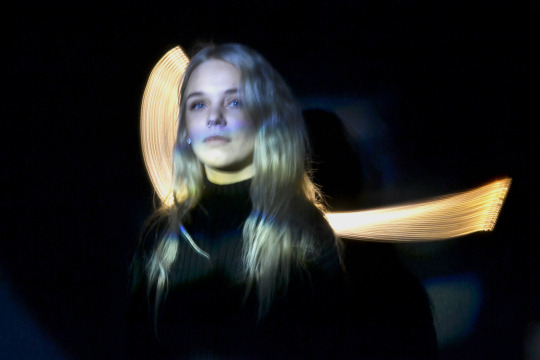
After I saw how the photos came out I noticed how the light patterns are similar to the photos I took of the moving cars on the motorway in the previous post so I have a plan to use the torches and slow shutter speed function on the DSLR camera to copy the light patterns from the photos in the studio.
5 notes
·
View notes
Video
White-necked Jacobin by Adam Rainoff Via Flickr: Capturing the White-necked Jacobin (Florisuga mellivora) in its natural habitat at Birdwatch La Conchita near Cali, Colombia, provided a remarkable opportunity to explore and document the vibrant dynamics of avian life. The photograph showcases this striking bird in mid-flight, its deep blue hood and green upperparts set against a softly blurred green background. Utilizing a shallow depth of field, I was able to isolate the bird from the surrounding foliage, emphasizing the brilliant coloration and intricate feather details that make the White-necked Jacobin a subject of endless fascination. From a technical standpoint, shooting this image required patience and a high shutter speed to freeze the rapid wing movement, capturing a moment of pure, ephemeral grace. Lighting played a crucial role, enhancing the iridescent quality of the bird's plumage. This image not only reflects my passion for avian photography but also underscores the importance of precision and timing in wildlife photography. It's a testament to the serene moments of nature that are often hidden in plain sight, waiting to be immortalized through the lens. ©2021 Adam Rainoff Photographer
#Cali#Valle del Cauca#Colombia#White-necked#Jacobin#Florisuga#mellivora#hummingbird#Birdwatch#La#Conchita#wildlife#nature#conservation#photography#birdwatching#tropical#travel#vibrant#color#green#blue#iridescent#feathers#flight#action#capture#fast#shutter#biodiversity
8 notes
·
View notes
Text
Canon EOS Rebel T7 DSLR Camera

Brand: Canon
Model Name: EOS REBEL T7 18-55mm f/3.5-5.6 IS II Kit
Photo Sensor Size: APS-H
Image Stabilization: true
Max Shutter Speed: 30 seconds
Min Shutter Speed: 1/4000 seconds
Metering Description: average,center-weighted,multi-zone,partial,spot
Exposure Control Type: Manual
Form Factor: DSLR
Effective Still Resolution: 24.1 MP

About this item
24.1 Megapixel CMOS (APS-C) sensor with is 100–6400 (H: 12800)
Built-in Wi-Fi and NFC technology
9-Point AF system and AI Servo AF
Optical Viewfinder with approx 95% viewing coverage
Use the EOS Utility Webcam Beta Software (Mac and Windows) to turn your compatible Canon camera into a high-quality webcam. Compatible Lenses- Canon EF Lenses (including EF-S lenses, excluding EF-M lenses)

Product Description
Perfect for beginners, this camera bundle offers the essential tools needed to take your SLR skills to new heights, all in one convenient package. No matter where your next adventure takes you, count on the EOS Rebel t7's impressive 24.1 Megapixel CMOS sensor and wide ISO range of 100-6400 (H: 12800) to capture high-quality images, even in low-light situations.

3 notes
·
View notes
Text
Area Scan Camera: A Comprehensive Guide to Technology and Applications

An area scan camera is a type of digital camera that captures images in a two-dimensional frame, making it ideal for applications requiring high-resolution, static, or slow-motion imaging. Unlike line scan cameras, which capture images one line at a time, area scan cameras provide full-frame images in a single exposure. This guide explores the technology behind area scan cameras, their key features, and their diverse industrial and scientific applications.
How an Area Scan Camera Works
An area scan camera consists of a sensor array that captures light intensity across a grid of pixels. When the shutter is activated, all pixels are exposed simultaneously, producing a complete image. The two main sensor types used in area scan cameras are:
CCD (Charge-Coupled Device): Known for high sensitivity and low noise, ideal for low-light conditions.
CMOS (Complementary Metal-Oxide-Semiconductor): Offers faster readout speeds and lower power consumption.
The choice between CCD and CMOS depends on factors like speed, resolution, and lighting conditions.
Key Features of Area Scan Cameras
Resolution: Ranges from standard VGA to ultra-high-definition (e.g., 20+ megapixels).
Frame Rate: Determines how many images the camera can capture per second.
Pixel Size: Affects light sensitivity and dynamic range.
Interface Options: Includes USB3, GigE, Camera Link, and CoaXPress.
Triggering Modes: Supports external triggers for synchronized imaging.
Applications of Area Scan Cameras
1. Industrial Inspection
Area scan cameras are widely used in automated quality control systems to detect defects in manufacturing processes. Examples include:
PCB inspection
Surface flaw detection
Dimensional measurement
2. Medical Imaging
In medical diagnostics, area scan cameras enable high-precision imaging in:
Microscopy
Endoscopy
X-ray imaging
3. Traffic and Surveillance
Traffic monitoring systems use area scan cameras for:
License plate recognition
Traffic flow analysis
Security surveillance
4. Scientific Research
Researchers utilize area scan cameras in:
Astronomy (star tracking, telescope imaging)
Biology (cell imaging, fluorescence microscopy)
Advantages Over Line Scan Cameras
While line scan cameras excel in continuous motion applications (e.g., conveyor belt scanning), area scan cameras offer:
Simpler setup (no need for precise synchronization with moving objects)
Better image quality for stationary or slow-moving subjects
Easier integration into existing vision systems
Choosing the Right Area Scan Camera
When selecting an area scan camera, consider:
Resolution requirements (higher resolution for detailed imaging)
Speed needs (high-speed applications require faster frame rates)
Lighting conditions (low-light environments may need CCD sensors)
Interface compatibility (ensure the camera works with your system)
Future Trends in Area Scan Camera Technology
Advancements in area scan camera technology include:
Higher resolutions with smaller pixel sizes
Improved low-light performance
AI-powered image processing for real-time analytics
1 note
·
View note